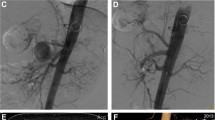Abstract
A 65-year-old woman who had been diagnosed as having microscopic polyangiitis developed sudden abdominal pain and entered a state of shock. Abdominal CT showed massive hemoperitoneum, and emergent angiography revealed a ruptured splenic artery aneurysm. After direct catheterization attempts failed due to tortuous vessels and angiospasm, transcatheter arterial embolization using an n-butyl cyanoacrylate (NBCA)-lipiodol mixture was successfully performed. Fifty days later, the patient developed sudden abdominal pain again. Repeated angiography demonstrated recanalization of the splenic artery and splenic artery aneurysm. This time, the recanalized aneurysm was embolized using metallic coils with the isolation method. Physicians should keep in mind that recanalization can occur after transcatheter arterial embolization using N-butyl cyanoacrylate, which has been used as a permanent embolic agent.


Similar content being viewed by others
References
Messina L, Shanley CJ (1997) Visceral artery aneurysms. Surg Clin North Am 77:425–442
Abbas MA, Stone WM, Fowl RJ et al (2002) Splenic artery aneurysms: two decades experience at Mayo clinic. Ann Vasc Surg 16:442–449
Wikholm G (1995) Occlusion of cerebral arteriovenous malformations with n-butyl cyano-acrylate is permanent. AJNR Am J Neuroradiol 16:479–482
Fournier D, Terbrugge K, Rodecsh G et al (1990) Revascularization of brain arteriovenous malformations after embolization with bucrylate. Neuroradiology 32:497–501
Gruber A, Mazal PR, Bavinzski G et al (1996) Repermeation of partially embolized cerebral arteriovenous malformations: a clinical, radiologic and histologic study. AJNR Am J Neuroradiol 17:1323–1331
Sadato A, Numaguchi Y, Taki W et al (1998) Nonadhesive liquid embolic agent: role of its components in histologic changes in embolized arteries. Acad Radiol 5:198–206
Canter HI, Vargel I et al (2002) Tissue response to N-butyl-2-cyanoacrylate after percutaneous injection into cutaneous vascular lesions. Ann Plast Surg 49:520–526
Sadato A, Wakhloo AK, Hopkins LN et al (2000) Effects of a mixture of a low concentration of n-butyl cyanoacrylate and ethiodol on tissue reactions and the permanence of arterial occlusion after embolization. Neurosurgery 47:1197–1205
Author information
Authors and Affiliations
Corresponding author
Rights and permissions
About this article
Cite this article
Matsumoto, K., Ushijima, Y., Tajima, T. et al. Recanalization of Splenic Artery Aneurysm After Transcatheter Arterial Embolization Using N-Butyl Cyanoacrylate. Cardiovasc Intervent Radiol 33, 187–190 (2010). https://doi.org/10.1007/s00270-009-9627-2
Received:
Revised:
Accepted:
Published:
Issue Date:
DOI: https://doi.org/10.1007/s00270-009-9627-2




